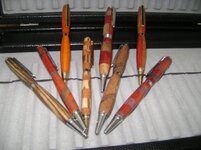Drcal
Member
My attempts at segmenting are generally poor, especially when I am working with a typical 3/4X3/4 inch blank that I have bought precut. There are rarely 2 sides that a square so it is impossible to cut a 90 degree cut. Stripes in a contrasting wood, for example, are generally a little crooked. The blank is too small for a jointer and table saw...what is it that I am missing? I would love to do some simple segmenting with straight lines. Help!
Carmen
Carmen

